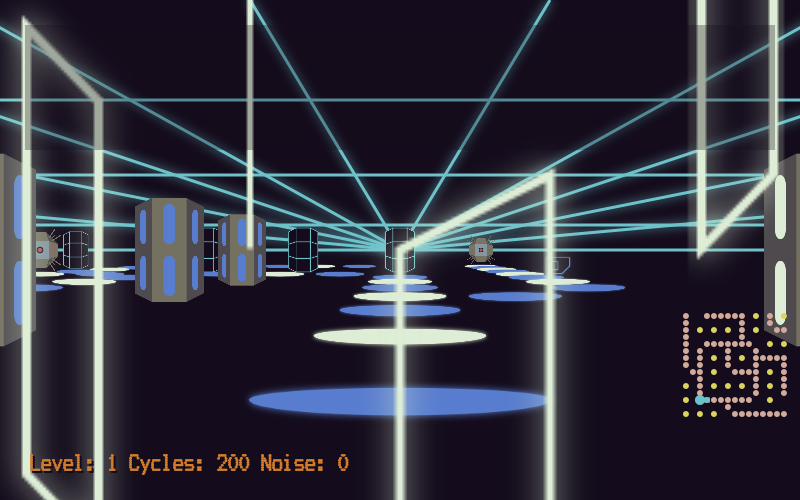
It all started nearly two years ago, when my plan to revive an even older graphics engine quickly gave birth to a roguelike prototype – a very traditional one apart from the first-person perspective. Well, and the core gameplay concept, but I never got that far because of fundamental difficulties. But said concept proved to work just as well with a cyberpunk theme, a choice made after switching from raytraced sprites to vector art revealed that my skills weren't yet up to par, so a more abstract environment was the way to go.
That was in spring. A month later, you could run around a random map, picking up keycards and activating terminals. Pretty fun, and most importantly intuitive, but not much of a game. Especially as it ran into an unexpected issue: I could think of various enemies with all kinds of attacks, but none of them made for interesting combat.
Between the need to work on a more marketable game port and the grand website migration this autumn, the whole thing was shelved for half a year or so. Once the hiatus ended, it took little to decide that procedural generation wouldn't work, so each level map would have to be randomly selected from a pre-made list – an approach hardly unheard of in roguelikes (see Ularn). As for the gameplay, well, why not make it about something else instead? Adding a move count limit turned Electric Rogue into a planning game, where several tries would be needed to figure out the shortest route around a level.
The result was more entertaining than it had any right to be. Too bare and repetitive, however, and I knew from experience most people would hate it. Worse, there was no guarantee that any given level would be solvable, since keycards could be located wherever. But even just a few bonus moves could make subsequent play trivial if you got lucky. And making it so that when running out of moves you'd start taking damage instead – while eliminating retries – made exploring the map a lot less meaningful.
It could have been the end of it, this time for real, but then I remembered a possible source of inspiration: Myst (no relation to the great classic), a minimal yet very challenging roguelike by Oleg Dolya, a.k.a. Watabou (creator of the much more famous Pixel Dungeon). Three new sprites and a bunch of coding later, the game had enemies that regularly became vulnerable as they came at you, making the otherwise simple combat into a tactical dance.
And the gameplay clicked! Suddenly there were all kinds of decisions to be made: which way to go next, when to fight and when to take a detour, whether to hunt down that tempting power-up or not. One last addition, this time inspired by another roguelike called Netpack – itself based on good old Pac-Man – was to turn the hunters into the hunted for a few moves every time you pick up a keycard.
Early feedback is very encouraging, and this could only happen because Electric Rogue draws from three different sources; even the premise can be traced back to my older game RogueBot. The first-person view, too, brings with it a notion of facing direction that most such games lack, with implications for the AI if nothing else. Besides, the feel itself matters: most players compare the game with old dungeon crawlers, which isn't the right guess as to where I got the idea all that time ago, but tells me how to advertise.
More about that, however, in another article.